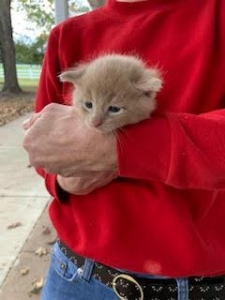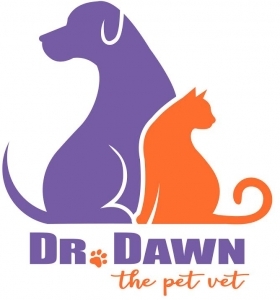
How and when you feed your kitten can have far-reaching effects on his health food and flavor preferences, and on your routine. Kittens seem to grow up so fast. With proper nutrition an average kitten will grow roughly a pound per month of age up to 10 months. They quickly develop play and stalking behaviors, which would help them hunt and fend for themselves if they didn’t have the good fortune of receiving daily catered meals.
We need to acknowledge that the way we typically feed cats is a far departure from how wild or feral cats eat. Surveys have found that the majority of cat parents feed both canned and dry food, with some feeding dry only, and a small minority feeding a canned diet only. In addition, many dry food bold are always full and refilled once or twice daily, some by the cat himself. The caloric content of a cup of dry cat food is variable, but a typical bowl might contain 200+ calories. for comparison, an average-sized mouse or bird is about 35-40 calories.
These dry food feeding practices are convenient for people but very well might be linked to rising feline obesity rates. Statistics in the U.S> show that 30-40 % of cats are overweight or obese. This is quite alarming and something you need to be aware of so you can develop healthy habits early to prevent obesity as your kitten browns into adulthood.
Basic Nutritional Needs
A kitten’s nutritional requirements are not very different from that of his adult counterparts, and the basic tenets of feeding a carnivore hold true. All cats should eat high-protein, low-carbohydrate and moderate-fat diets. Growing kittens need even more calories per pound than adults, and this is best achieved through higher protein and fat levels. The food should be easily digestible. Digestibility is not listed on the label bt might be available if you call the manufacturer. If you do this, try to find a food that is 85-90% digestible.
Kittens should also consume high levels of fatty acids, which are commonly found in fish oils. A specific fatty acid, called docosahexaenoic acid (DHA) is critical for brain and eye development, and is often listed on labels. Fatty acids also have been shown to be beneficial for skin, heart, joints and inflammatory disease, so fish oils are a healthy dietary supplement for any cat or kitten.
Your first decision when feeding your kitten is: dry, canned or both. I recommend feeding kittens 1/4 to 1/2 can of moist food once or twice daily as a small meal, while leaving dry food out to graze on. The combination ensures that your kitten obtains enough calories. Feeding both canned and dry food is also beneficial because kittens develop learned food preferences from weaning up to roughly 6 months of age. They learn to identify certain tastes, shapes and textures as food. Even if you don’t continue with this combination, it is helpful for them to be able to eat either type later in life
 There are certain medical conditions in cats, urinary tract disease for example, in which a canned diet is preferred. However, some cats simply will not eat canned food, and this can present a therapeutic challenge. Early exposure to canned food can lead to more food flexibility, making them potentially more amenable to accepting new texture diets when older.
There are certain medical conditions in cats, urinary tract disease for example, in which a canned diet is preferred. However, some cats simply will not eat canned food, and this can present a therapeutic challenge. Early exposure to canned food can lead to more food flexibility, making them potentially more amenable to accepting new texture diets when older.
Allowing and encouraging kittens to be curious about new foods, you are less likely to end up with a cat that is a picky eater. At least it is theorized as such. Yet, some studies have shown that kittens’ preferences might be influenced by what their mother ate during pregnanc. So offer a variety, but ultimately the kitten will decide what he likes.
A Recipe for Obesity
Feed kitten foods until your cat is 1 year old. Then transition to an adult diet. To avoid stomach upset, do this over a 1-2 week period by mixing the new food with the old, slowly. Neutering or spaying reeves the hormone-producing organs (ovaries or testicles.) After this surgery, they are more likely to gain weight, and thus food intake needs are reduced 20-30%. You should feed that much less, therefore, and often it is less than you think.
 Cats prone to obesity are indoor-only, neutered or spayed, eating free-chooic dry food. These cats have low energy needs because they do not have to hunt or defend themselves as in the wild, and have a lower metabolic rate after being neutered. High-carbohydrate foods, particularly those “self-fed”, are culprits. You can help by trying to induce them to get more exercise, and have an enriched environment for them to easily do so (see upcoming post). You can and should control the amount of food they can eat, not them. Therefore, avoid self feeders, and do not leave a heaping bowl of dry food out for cats older than a year. Measure amounts of dry kibble daily. Try putting the dry food in a plastic food ball, or puzzle treat ball, that makes him work for his food by rolling the ball around until the kibble falls out. This will help minimize boredom eating as well. Even better: Offer canned diets. They are more similar to natural diets, which are high in protein and moisture, and low in carbohydrate.
Cats prone to obesity are indoor-only, neutered or spayed, eating free-chooic dry food. These cats have low energy needs because they do not have to hunt or defend themselves as in the wild, and have a lower metabolic rate after being neutered. High-carbohydrate foods, particularly those “self-fed”, are culprits. You can help by trying to induce them to get more exercise, and have an enriched environment for them to easily do so (see upcoming post). You can and should control the amount of food they can eat, not them. Therefore, avoid self feeders, and do not leave a heaping bowl of dry food out for cats older than a year. Measure amounts of dry kibble daily. Try putting the dry food in a plastic food ball, or puzzle treat ball, that makes him work for his food by rolling the ball around until the kibble falls out. This will help minimize boredom eating as well. Even better: Offer canned diets. They are more similar to natural diets, which are high in protein and moisture, and low in carbohydrate.
Common myth: Dry foods clean teeth
This is not true. After all, dry foods don’t clean our teeth. Many cats that eat dry food, in fact, do not even chew it, but swallow it whole. The only exceptions are the specially formulated dental diets, which have been proven to reduce the amount of bacteria-laden plaque and tartar. Other than this small subset of prescription diets, cats can develop dental disease just as easily from eating dry food as canned.
So, think about this next time you get a kitten or are feeding your adult cat for that matter. Hope you found it helpful
Dr. Dawn
Please share and subscribe here





